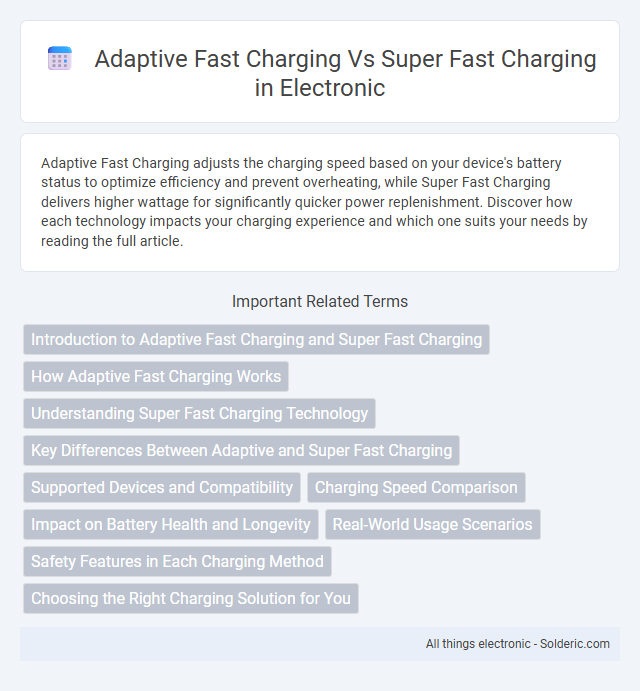Adaptive Fast Charging adjusts the charging speed based on your device's battery status to optimize efficiency and prevent overheating, while Super Fast Charging delivers higher wattage for significantly quicker power replenishment. Discover how each technology impacts your charging experience and which one suits your needs by reading the full article.
Comparison Table
| Feature | Adaptive Fast Charging | Super Fast Charging |
|---|---|---|
| Charging Technology | Samsung proprietary fast charging | Samsung's advanced fast charging standard (based on USB PD 3.0 PPS) |
| Charging Speed | Up to 15W | Up to 25W or higher, depending on device |
| Charging Protocol | Adaptive voltage and current based on battery status | Programmable Power Supply (PPS) with dynamic voltage/current control |
| Compatibility | Limited mainly to Samsung devices | Supported on newer Samsung devices and USB PD compatible devices |
| Connector Type | Micro-USB or USB-C (device dependent) | USB-C |
| Charging Efficiency | Moderate efficiency | Higher efficiency with less heat generation |
| Release Era | Introduced around 2014-2015 | Introduced around 2019 |
Introduction to Adaptive Fast Charging and Super Fast Charging
Adaptive Fast Charging is a technology by Samsung that optimizes charging speed by adjusting power output based on the device's capacity, typically delivering up to 15W of power. Super Fast Charging, based on USB Power Delivery 3.0 PPS protocol, significantly increases charging speed, offering up to 25W or higher for compatible Samsung devices. Both technologies aim to reduce charging time while protecting battery health through intelligent power management.
How Adaptive Fast Charging Works
Adaptive Fast Charging works by intelligently adjusting the power output based on your device's battery status and temperature to optimize charging speed and safety. This technology communicates with your device to deliver the highest possible current without overheating or damaging the battery. By dynamically controlling voltage and current, Adaptive Fast Charging minimizes charging time while preserving battery health over the long term.
Understanding Super Fast Charging Technology
Super Fast Charging technology utilizes enhanced power delivery standards and advanced heat management systems to significantly reduce your smartphone's charging time, often exceeding 25W power output compared to Adaptive Fast Charging's typical 15W to 18W. This results in quicker, more efficient energy transfer while maintaining battery health through intelligent voltage and current regulation. Understanding Super Fast Charging helps you optimize your device's charging speed while ensuring safety and longevity.
Key Differences Between Adaptive and Super Fast Charging
Adaptive Fast Charging supports power outputs generally up to 15W to 25W and dynamically adjusts to the device's battery status to optimize charging speed without overheating. Super Fast Charging, often associated with Samsung's latest technology, leverages higher power levels typically between 25W and 45W or more, utilizing USB Power Delivery (USB-PD) 3.0 and Programmable Power Supply (PPS) protocols for significantly faster charging times. The primary difference lies in power delivery standards and maximum wattage, where Adaptive Fast Charging prioritizes compatibility and safe, swift charging, while Super Fast Charging targets ultra-rapid replenishment with advanced thermal management.
Supported Devices and Compatibility
Adaptive Fast Charging supports a wide range of Samsung devices, including many Galaxy models released before 2019, ensuring broad compatibility with older smartphones and tablets. Super Fast Charging, based on USB Power Delivery (USB PD) 3.0 with Programmable Power Supply (PPS), is designed for newer flagship devices from Samsung, such as the Galaxy S20 and later, providing faster charging speeds but limited to compatible devices. Your choice of charger depends on your device's support for these standards to achieve optimal charging efficiency.
Charging Speed Comparison
Adaptive Fast Charging typically offers charging speeds up to 15-25W, efficiently powering compatible devices within a moderate timeframe. Super Fast Charging, leveraging advanced technology and higher wattage often exceeding 25W and reaching up to 65W or more, significantly reduces charging time, enabling your smartphone to reach full battery capacity much faster. This speed comparison highlights the superior performance of Super Fast Charging for users seeking minimal downtime and rapid energy replenishment.
Impact on Battery Health and Longevity
Adaptive Fast Charging delivers moderate power levels that reduce excessive heat generation, thereby preserving battery health and extending longevity by minimizing stress on lithium-ion cells. Super Fast Charging operates at significantly higher wattages, increasing charge speed but generating more heat and potentially accelerating battery wear if used frequently without proper thermal management. Manufacturers implement advanced cooling systems and optimized charging algorithms to balance rapid charging benefits with battery durability in Super Fast Charging technologies.
Real-World Usage Scenarios
Adaptive Fast Charging excels in everyday scenarios such as topping up a smartphone during short breaks or overnight charging, providing efficient power without overheating. Super Fast Charging is ideal for urgent situations requiring rapid battery replenishment, like busy professionals needing a quick boost before meetings or travelers with limited charging time. Both technologies enhance user convenience, but Super Fast Charging offers significantly shorter charging durations in real-world usage.
Safety Features in Each Charging Method
Adaptive Fast Charging incorporates multiple safety features such as temperature control, voltage regulation, and overcurrent protection to prevent overheating and battery damage. Super Fast Charging advances these safety measures by using intelligent communication between the charger and device to dynamically adjust power output, ensuring optimal charging speed without compromising battery health. Your device benefits from enhanced protection protocols in both methods, but Super Fast Charging prioritizes real-time safety adjustments for more efficient and secure energy transfer.
Choosing the Right Charging Solution for You
Adaptive Fast Charging offers efficient power delivery compatible with many Samsung devices, providing a reliable balance between speed and battery health. Super Fast Charging leverages advanced technology with up to 45W power output, drastically reducing charge times for supported smartphones like the Galaxy S21 series. Assess your device compatibility and daily charging needs to select the optimal solution that ensures swift energy replenishment without compromising battery longevity.
Adaptive Fast Charging vs Super Fast Charging Infographic

 solderic.com
solderic.com